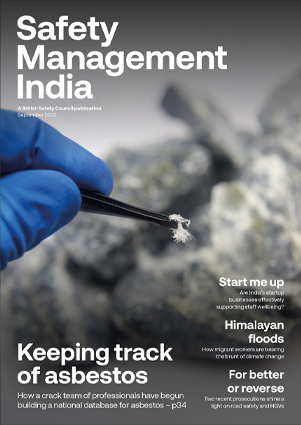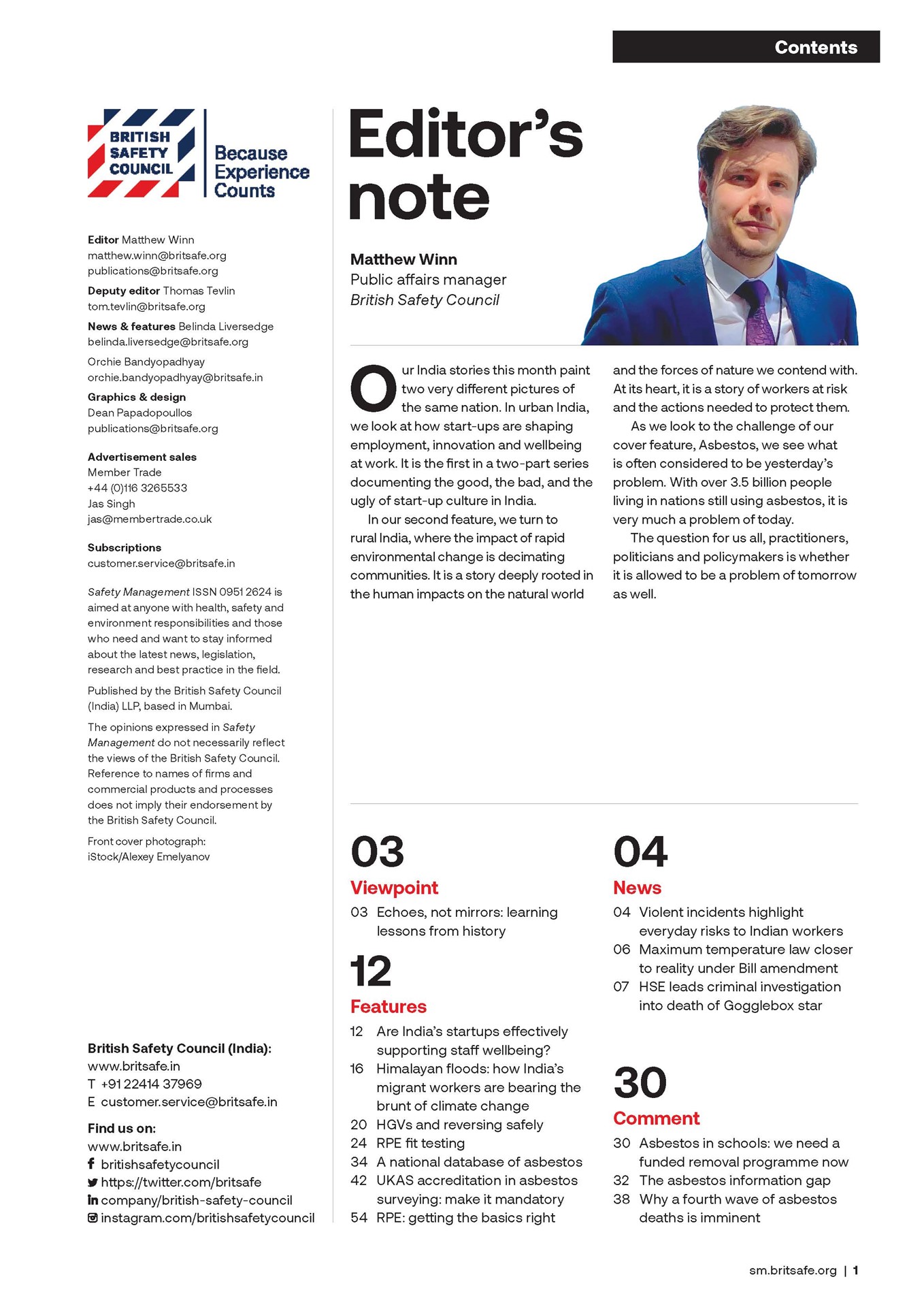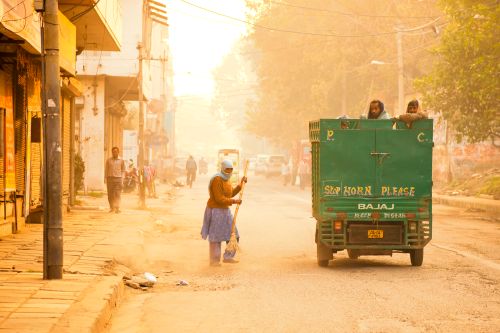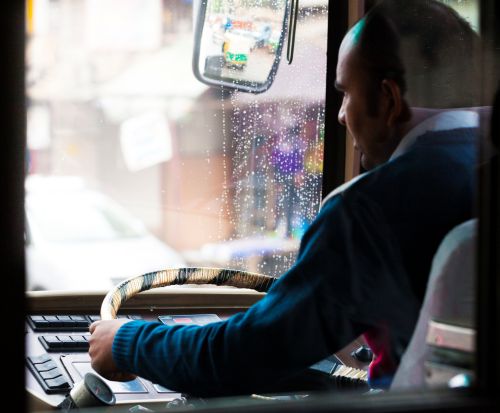Every autumn and winter, Delhi experiences terrible air pollution that places the health of its 40 million residents at grave risk. But government measures to alleviate the problem by temporarily closing construction sites mean hundreds of thousands of daily-wage labourers are being left without wages and a means of financial support.
Features
Delhi’s air pollution problem leaves construction workers jobless and without pay
It is that time of year again in New Delhi when the familiar haze and fog roll in, and the capital is blanketed in choking smog. The city’s 40 million residents prepare themselves for another autumn season of toxic air arising from a combination of vehicle emissions, factory fumes, construction dust and smoke from agricultural stubble burning in neighbouring Punjab and Haryana.
A climatic phenomenon called temperature inversion, coupled with cold air and sluggish winds, traps air pollutants close to the ground during the autumn period. By the end of October, the city’s Air Quality Index (AQI) had reached ‘severe’ levels, crossing 400 on 30 October, with the worst yet to come during November.

For Delhiites, this is an annual problem every autumn. The air thickens, the wheezing begins and emergency government measures designed to reduce air pollution return. Most of the capital’s residents complain of wheezing, chest tightness and stinging eyes, and hospitals across the National Capital Region (NCR) see a surge in the number of patients. However, for hundreds of thousands of daily-wage labourers – especially construction workers – the pollution season in Delhi–NCR (National Capital Region) also means another grave problem: a sudden loss of livelihood.
Ban on construction activities
In recent years, the Commission for Air Quality Management (CAMQ), a statutory body established by the Central Government to address air pollution in the NCR and surrounding areas, has banned construction activities as part of its Graded Response Action Plan (GRAP), a set of measures implemented to combat deteriorating air quality during the winter months in Delhi–NCR.
For an estimated 800,000 to one million daily wage construction labourers, mostly migrants who have travelled to the capital in search of work, the ban on construction activities means instant unemployment.
In 2024, when restrictions under Stage IV of GRAP triggered a blanket ban on non-essential construction work, hundreds of construction workers staged a protest near the Delhi Lieutenant Governor’s office in Civil Lines. The demonstration, organised by the Building Workers Union, which is affiliated with the All India Central Council of Trade Unions (AICCTU), sought compensation for loss of earnings arising from the ban.
The workers submitted a memorandum to the Lieutenant Governor and the Labour Department, demanding daily financial compensation of Rs 783 for unskilled workers, Rs 868 for skilled workers and Rs 954 for highly skilled workers. They also demanded a structured policy to support them during pollution-related shutdowns.
“Pollution control cannot come at the cost of survival,” stated a union spokesperson. “Every year bans are imposed, and thousands of workers are left without income or support. The [Delhi–NCR] government must adopt a sustainable plan that protects both the air and the livelihoods [of construction workers].”
In response, the Delhi Government announced a financial relief package of Rs 8,000 for more than 90,000 registered construction workers. However, many unions argue that this one-time relief payment does little for the vast number of unregistered and informal workers who remain outside the welfare net.
‘Cloud seeding’ seeks to create rain
This year, Delhi’s newly elected Bharatiya Janata Party (BJP)-led government announced plans to attempt to reduce air pollution in the capital by artificially creating rain through a process of ‘cloud seeding’.
The city’s authorities collaborated with the Indian Institute of Technology (IIT) Kanpur to conduct three cloud-seeding trials in late October. The ideas was to attempt to kick-start rainfall that could reportedly disperse air pollutants, like PM2.5, fine particulate matter arising from sources such as vehicle emissions, industrial processes, dust from agricultural activities, and the burning of solid fuels for heating and cooking.
However, none of the attempts produced significant rain, with experts blaming “low moisture content in the clouds” for the failure of the experiments.
This is not the first time Delhi has attempted cloud-seeding. “Delhi first experimented with cloud seeding in 1957, and again in the early 1970s,” climate scientist Roxy Mathew Koll from the Indian Institute of Tropical Meteorology (IITM), Pune, told PTI (Press Trust of India).
The experiments of the 1950s and 70s were aimed at mitigating drought by creating rainfall, but the latest trials were the first time the country has attempted to use cloud-seeding technology to minimise air pollution.
Cloud seeding, according to the Indian Institute of Technology, Madras, is a technique in which cloud-forming particles are introduced into clouds in an attempt to enhance rainfall.
“Cloud seeding is not a magic bullet,” said Professor Manindra Agrawal, director of the Indian Institute of Technology, Kanpur. “It can provide temporary relief, but the only sustainable solution is to control the sources of [air] pollution.”
‘Misplaced priorities’
However, many construction workers who have been laid off as the capital city battles to reduce air pollution from building sites say the Delhi-NCR Government’s failed experiment, which reportedly cost Rs 3.21 crore, displays misplaced priorities. “During the Covid lockdown, we received Rs 5,000 a month as support,” said Subhash Singh, a migrant construction labourer from Bhopal, who has been laid off because construction work has been halted. “Why can’t they do that again, instead of spending crores on artificial rain?”
Taking note of the annual loss of wages for Delhi’s construction workers as work is suspended each autumn, in September the Supreme Court asked the Commission for Air Quality Management to consider alternative solutions to the air pollution problem in Delhi–NCR, instead of imposing a blanket ban on construction work during the winter season, Live Law reported.
Judges led by Chief Justice B.R. Gavai and Justice K. Vinod Chandran noted that the ban “adversely affects the livelihood of daily-wage workers”, many of whom have travelled hundreds of kilometres from other states to find work in the capital. “Workers moving from different parts of the country are left without work during those periods,” the bench observed, according to Live Law.
The Supreme Court also noted that schemes to compensate construction workers for loss of earnings are poorly implemented. “Various applications have been filed before this court, alleging that the compensation is not properly paid,” the judges said. The Court also directed the CAQM to consult the Delhi–NCR government – and neighbouring states such as Uttar Pradesh, Punjab and Haryana, where activities like agricultural stibble burning contribution to air pollution in Delhi–NCR – about concrete plans to prevent pollution rather than imposing prohibition orders on construction work, within three weeks of its ruling, which was issued on 17 September.
For workers like Singh, the anxiety begins as soon as the air turns grey. “Our contractor has warned that work might stop any day,” he says. “I try to work extra shifts now because once construction stops, I’ll have to look for odd jobs, perhaps washing dishes in a dhaba (roadside café). But there’s no guarantee I’ll find work. There will be many like me looking for the same.”
Another worker, Shibu Mandal, a welder from Siliguri in West Bengal, has already begun looking for work in roadside eateries to make ends meet. “We come to Delhi to build the city,” he says, “but when the air gets bad, the city forgets us.”
Variety of approaches
Delhi’s air pollution crisis is not new, and neither are the city government’s attempts at solutions. Over the years, the Delhi–NCR Government has tried a variety of measures to improve air quality, such as ‘smog towers’, odd-even traffic restrictions (where cars with odd and even number plates are banned on alternate days), road-watering trucks and bans on the production, storage, sale and use of firecrackers, which contribute to poor air quality during Diwali. Most of these measures have been criticised as expensive, temporary and largely ineffective.
Experts argue that these are simply ‘firefighting’ measures that fail to tackle the root causes of air pollution, which are mainly vehicle emissions, industrial pollutants, construction dust and agricultural stubble burning. They say the focus remains on implementing an emergency response rather than the prevention of air pollution. “We need systemic reforms in transport, energy and waste management,” said one air pollution expert. “Otherwise, this cycle of crisis will continue.”
As well as the negative impact on the livelihoods of construction workers, Delhi’s pollution has dire implications for public health, including the health of outdoor workers. The 2025 Lancet Countdown report paints a grim picture of India’s air quality crisis, with 1.72 million deaths attributed to fine particulate matter (PM2.5) exposure in 2022, marking a 38 per cent rise since 2010. The deadly impact is driven largely by fossil fuel combustion, particularly from coal-fired power plants and petrol and diesel-powered vehicles. The economic cost in 2022 was nearly USD 340 billion, close to 9.5 per cent of India’s GDP, says the report.
Although India’s Central Government has disputed some of the mortality estimates, experts argue the health toll is undeniable and warn that only urgent pollution control measures and a swift transition to cleaner energy can prevent further harm to public health.
Doctors warn that prolonged exposure to PM2.5 (particles smaller than 2.5 micrometres, that can penetrate deep into the lungs and occasionally enter the bloodstream) can cause systemic inflammation and carcinogenicity. These pollutants are linked to stroke, heart disease, lung cancer, pneumonia, cataracts and chronic respiratory conditions like asthma and COPD.
“Those exposed to poor air for long periods face a higher risk of chronic respiratory and cardiovascular diseases,” says Dr Naresh Gupta, former director-professor of medicine at Lok Nayak Hospital in Delhi and chairperson of the Haemophilia and Health Collective of North (HHCN). “This is not just a seasonal problem, it’s a public health emergency.”
As winter progresses and politicians trade barbs about the reasons for failures to improve air quality in Delhi, the capital’s skyline again faded into a toxic blur. But for daily-wage workers, the annual ban on construction work means another night without income, another meal skipped and another payment to family members back home in faraway states delayed.
Delhi’s fight for clean air cannot come at the expense of its most vulnerable citizens, argue campaigners. Experts say the Delhi–NCR Government needs to implement integrated, year-round pollution control measures, that address emissions at source, enforce industrial regulation, improve public transport, and support cleaner fuels. The Government also needs to establish strong social safety nets for those whose livelihoods are disrupted.
Until that balance is achieved, Delhi’s winter will remain a season of both breathlessness and joblessness.


FEATURES

Delhi’s air pollution problem leaves construction workers jobless and without pay
By Orchie Bandyopadhyay on 10 November 2025
Every autumn and winter, Delhi experiences terrible air pollution that places the health of its 40 million residents at grave risk. But government measures to alleviate the problem by temporarily closing construction sites mean hundreds of thousands of daily-wage labourers are being left without wages and a means of financial support.

India’s road rage crisis: how professional drivers are bearing the brunt
By Orchie Bandyopadhyay on 10 November 2025
High profile reports of violent attacks on people who drive for work purposes, like bus and delivery drivers, have shone a spotlight on the growing problem of road rage in India. Commentators say it is now time for the Government to step up prosecutions of those who act aggressively on the road, while educating drivers on stress management techniques, to tackle the problem.

